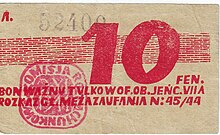Token money
This article has multiple issues. Please help improve it or discuss these issues on the talk page. (Learn how and when to remove these messages)
|

Token money, or token, is a form of money that has a lesser intrinsic value compared to its face value.[1][2] Token money is anything that is accepted as money, not due to its intrinsic value but instead because of custom or legal enactment.[3] Token money costs less to produce than its face value.[3] A banknote, e.g. a five-pound note, is token money because despite its value being 5 pounds it only costs significantly less to produce.[3] A gold coin is not considered token money.[3] The Token money system has been adopted in many businesses around the world as an effective way to exchange value between companies and customers.[4] Token money as a system is predominantly used in mobile games, but is also used in the realm of e-commerce.[4] Token money is similar to fiat money which also has little intrinsic value, however they differ in that token money is a limited legal tender.[5] The adoption of token money has improved transaction efficiency, as the practicalty of transacting with sums of gold poses a larger security risk. In a commodity economy, money is a measure of the value of goods and services (prices) within a sovereign country or the same economy, as well as a particular commodity to pay off debts.[6] The token is also used as a medium of exchange, as a store of value, and as a unit of account. Digital currencies using decentralized blockchain technology are also a form of token money.[7]
History
[edit]In Ancient Greece and the Roman Empire, copper coins were used for small transactions and were issued a monetary value greater than the value of the metal itself.[3] This established the principle of token money, which is the nature of coinage in contemporary society.[3] Plato distinguished between tokens and commodities.[8] In Medieval Indian history, Mohammad Bin Tughlaq (c.1290-1351) issued copper currency called Tanka as token money whose value was legally set equal to silver coin, and is considered the world's first truly token currency.
In the early nineteenth century, David Ricardo suggested issuing token money as long as it did not affect commodity standard.[9]
Physical tokens
[edit]
Token money has less intrinsic value compared to its face value.[10] If the token money is metallic it is commonly made out of cheaper metals such as copper and nickel.[11][12]
Token money is also money whose face value exceeds its cost of production, i.e. the intrinsic value is lower than the extrinsic value. This means that the actual worth of a note or coin is much less than what we use it for. The cost of production of token money is less than its actual value, for example with convertible currency, collector notes, souvenirs, coupons, some retired US banknotes and per 1986 banknotes printed in regulation size and only on one side with authorization are actually worth more dollars than when issued.[13][14]
With token money, exchanges are not considered fully complete because the exchange of value is not equivalent.[15] Value is hoped to be rendered at some future time. Examples of this include bills of exchange or negotiable instrument and certificates.[15]
Token money does not have free coinage.[11]
See also
[edit]References
[edit]- ^ Rutherford, Donald (2002). "token money". Routledge Dictionary of Economics (2nd ed.). London and New York: Routledge. p. 564 – via Internet Archive.
- ^ Pettinger, Tejvan. "Token Money". Economics Help. Archived from the original on 2021-04-17. Retrieved 2021-04-09.
- ^ Jump up to: a b c d e f "Routledge Dictionary of Economics", Abingdon, UK: Taylor & Francis, 1992, pp. 1–502, doi:10.4324/9780203208878_routledge_dictionary_of_economics, ISBN 9780203208878, archived from the original on 2023-10-20, retrieved 2021-04-09
{{citation}}: Missing or empty|title=(help) - ^ Jump up to: a b Sreekanth, N. P.; Gupta, Deepak (2020-10-30), "Token Money: A Study on Purchase and Spending Propensities in E-Commerce and Mobile Games", Information and Communication Technology for Intelligent Systems, Smart Innovation, Systems and Technologies, vol. 196, Singapore: Springer Singapore, pp. 507–514, doi:10.1007/978-981-15-7062-9_50, ISBN 978-981-15-7061-2, S2CID 228898344, archived from the original on 2023-10-20, retrieved 2021-04-09
- ^ "token". dictionary.cambridge.org. Archived from the original on 2021-03-19. Retrieved 2021-03-30.
- ^ Orchard. (2017). Token. Atlanta Review, 23(2), 76–.
- ^ Bird; Wirtz, Bird LLP-Johannes; Jünemann, Michael (23 May 2019). "ICO: Legal Classification of Tokens | Lexology". www.lexology.com. Archived from the original on 2022-04-06. Retrieved 2021-03-30.
- ^ Karimzadi, Shahzavar (2012). Money and its Origins. Routledge. p. 139. ISBN 9781136239021.
- ^ Sargent, Thomas J (1 April 2019). "Commodity and Token Monies" (PDF). The Economic Journal. 129 (619): 1457–1476. doi:10.1111/ecoj.12587. Archived (PDF) from the original on 2018-09-13. Retrieved 2018-09-13. Second page of web version.
- ^ "Definition of TOKEN MONEY". www.merriam-webster.com. Archived from the original on 2014-01-19. Retrieved 2021-10-27.
- ^ Jump up to: a b Mehta, B. K. (2000). Principles of Money and Banking. Motilal Banarsidass. pp. 33–34. ISBN 8120829166. Archived from the original on 6 April 2022. Retrieved 2 January 2017.
- ^ Tsoukalas; Falk, B. H. (2020). "Token-Weighted Crowdsourcing". Management Science. 66 (9): 3843–3859. doi:10.1287/mnsc.2019.3515.
- ^ "to say that coins are token money means that". onnuri.org. Archived from the original on 2021-07-25. Retrieved 2021-03-30.
- ^ Stannard, Clive (25 March 2022). "Small change in Campania from the Fourth to the First Century BC, and the Newly Discovered Second Punic War Roman Mint of Minturnae". www.researchgate.net. Retrieved 2022-03-25.
...the small units and of copper-based alloys, in which it was possible to make coins of usable size at a relatively low cost...
- ^ Jump up to: a b Kuzminski, Adrian (2013). The Ecology of Money: Debt, Growth, and Sustainability. Lexington Books. p. 54. ISBN 9780739177181. Archived from the original on 2 January 2017. Retrieved 2 January 2017.
